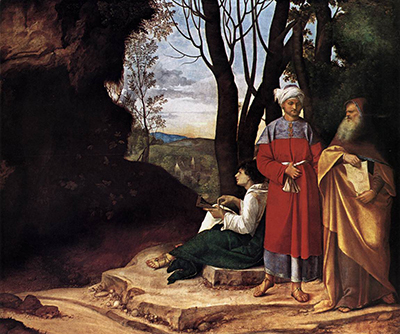A key figure of the High Renaissance, the Italian painter Giorgione lived only until the age of thirty two or thirty three (he lived between 1477 or 1478 and 1510)
Nevertheless, in those three decades of life he created works of art that endure right up into the present day.
Though he was born Giorgio Barbarelli da Castelfranco, he went by the simpler name of Giogione, and it is by this version of his name that we continue to refer to him today.
He was born in Venice (or to be more precise in Castelfranco Veneto which lay 40 kilometres from Venice, in a more inland location), and this location marked his work as he became part of what is known as the Venetian School of Renaissance art. Another acclaimed member of the Venetian School was Titian, for example.
Though Giorgione may have been a very prolific artist, there are only 6 works of art in existence today - all of them oil paintings - that art historians definitively say are definitely painted by him. This is not surprising: when artists were members of a particular school, they influenced, and were influenced by, other members of that school.
In addition, members of the same artistic school would frequently collaborate with each other, or with their apprentices, on paintings. As such, it is often difficult to tell which member of a given school created a given work of art, or even to ascribe a particular art work to a single artist.
Art historians wishing to learn more about Giorgine can consult the famous painter Vasari's treatise entitled Lives of the Most Excellent Painters, Sculptors, and Architects, which contains one of the most expansive early discussions of Giorgione's life and work.
Giorgione's painting style is typical of the High Renaissance. Bold portraiture against a dark background - something also favoured by Leonardo da Vinci - is a hallmark of Giorgione's style. Some of Giorgione's most famous portraits in his lifetime depicted nobles and other celebrities of the day, and were specially commissioned by those people.
One key example is his portrait of the Doge Agostino Barbarigo, which he executed when aged only around 23. Another example is his portrait of Consalvo Ferrante. It is important to note, however, that conventional canvas paintings in a frame were not the only way that Giorgione expressed himself artistically. He was also commissioned to paint altarpieces, for instance, and to provide murals as interior decoration in the Doge's palace itself.
No discussion of Giorgione's life and work would be complete without making mention of his relationship with Titian. These two artists were strong influences on each other, and they developed their artistic styles in symbiosis with each other.
Both Giorgione and Titian trained together as apprentices to the older Venetian artist Giovanni Bellini, and in fact both apprentices lived with Bellini in his house. Titian cemented his relationship with Giorgione by painting several portraits of him.
If we had to pick one single artwork to be emblematic of Giorgione's style it would probably be one of his last works: the Sleeping Venus, which he created in 1510. This painting depicts a reclining nude in resplendent colours against a lushly imagined landscape.
The richness of colours and the sumptuousness of the drapery that the nude woman is reclining on (which has deep, shadowy folds characteristic of High Renaissance love of opulent details) make this a gorgeous example of Venetian art. One might even compare it to other Renaissance works such as the Mona Lisa, which also depict enigmatic female figures against naturally beautiful landscapes.




